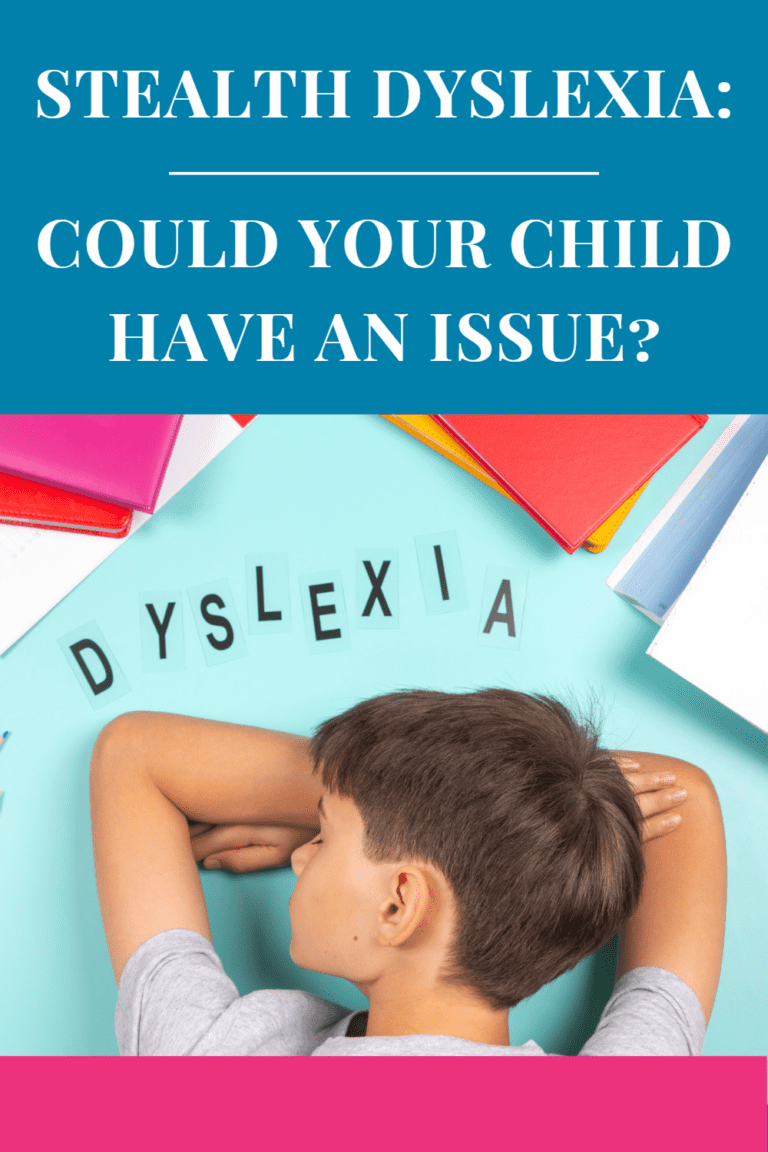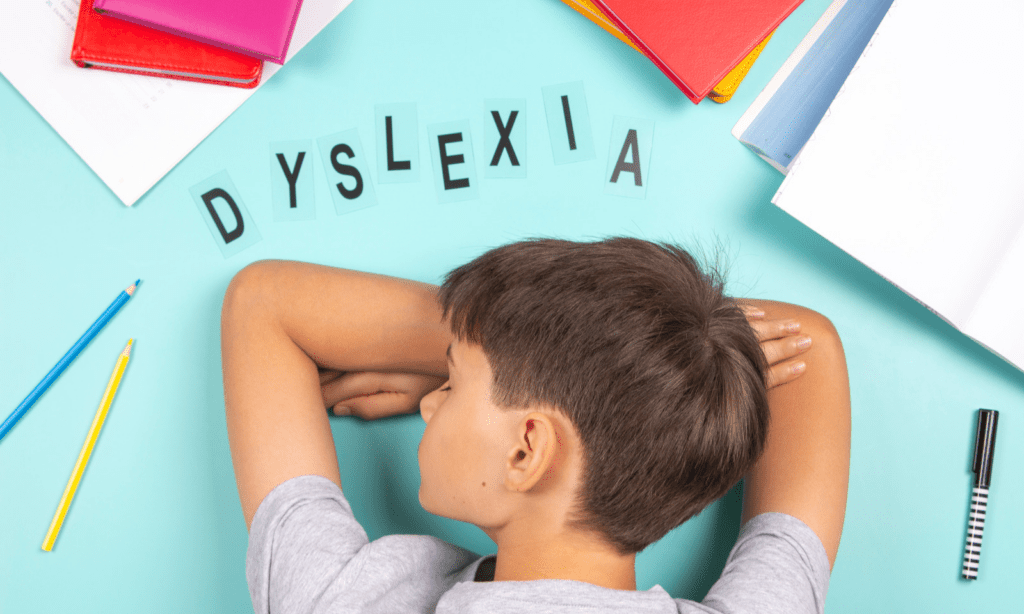Reese was 17 years old when he was finally diagnosed with dyslexia. He was a fluent reader and slipped through the cracks until his senior year in high school.
When you hear ‘dyslexia’ the first image that comes to mind for most people is someone who can’t read.
It’s exactly why stealth dyslexics and kids with dysgraphia so often slip through the cracks.
As Reese’s Dad said “well if he can read – what’s the problem? How can he even have dyslexia?”
For years Reese had managed to coast because he was gifted and had developed compensations to get around his weaknesses with reading and especially writing.
It’s no wonder Reese’s self-esteem was eroding. He knew he was smart in many ways which made it all the more confusing why it seemed impossible to get his thoughts down on paper.
What Is Stealth Dyslexia?
Stealth Dyslexia as defined by Dr Fernette and Brock Eide is when a person is able to read and comprehend, is often bright but struggles with oral reading, sounding out new, long words and often has difficulties from moderate to severe with spelling and writing.
If these kids do get a diagnosis – dysgraphia is often their biggest challenge.
Why These Kids Are Mistaken for Lazy or Careless
Their challenges are often missed and blamed on factors that teachers and parents believe to be within the child’s control.
These kids are often thought of as lazy, careless, not working to their potential or even defiant. They are constantly told they just need to focus better and to ‘apply themselves’.
And it’s no wonder others assume they are capable and are simply not trying because they often have above average IQ’s. They can tell you all about a topic verbally and have excellent critical thinking but ask them to do it on paper and it’s another story.
The Difficulty of Detecting Stealth Dyslexia
Those with stealth dyslexia are most likely to slip through the cracks in their formative years in elementary school, sometimes even getting by in middle school. It’s usually in high school that the real frustration and struggle becomes undeniable.
While they appear to read fluently, there are quite a few compensations that they rely on that goes unnoticed by their educators. Where they fall short with weak auditory and visual processing that’s necessary for reading, they instead use their superior oral language skills, above average IQ and highly developed contextual memory and problem solving skills to read and comprehend.
These kids get the gist of the story but often do it by relying on the overall context of a text, using background knowledge to interpret the meaning without actually decoding all the words in a text.
Still other stealth dyslexics decode fluently but when it comes to writing and the output of their thoughts, the task becomes laborious if not impossible.
Stealth Dyslexia VS. Classic Dyslexia and The Dyslexia Spectrum
In classic dyslexia, kids do poorly in reading and writing right from the start. It’s hard not to notice.
Some kids have mild dyslexia and are brushed off as just being ‘weak learners’. They are frequently known to be ‘hard workers’ and therefore don’t get noticed until later. It’s often not until grade 4 or 5 when kids are reading to learn rather than learning to read that it becomes obvious there is a reading disability.
Stealth dyslexics on the other hand may go their whole life without being aware or anyone detecting there is a problem because they may have only mild impairments with auditory and visual processing. Their high IQ or giftedness allows them to use compensations to balance out their weaknesses.
Yet a 2005 study by Dr. Fumiko Hoeft, out of the University of California found stealth dyslexics have the same brain wiring as classic dyslexia. However, they have heightened activity in the brain related to executive functioning which allows them to have good reading comprehension by relying on their superior problem solving skills to compensate for their weaknesses with decoding.
Other studies have confirmed that stealth dyslexics’ neurological and neuropsychological testing showed the same deficits with auditory, visual, language and motor processing abilities.
The Problem with How Schools Assess Reading Ability
Like Reese these kids are missed because schools do not screen for markers for dyslexia or assess a child’s neurological abilities related to reading or writing. They assess based on if a child can read at grade level which stealth dyslexics can do.
If they have difficulties with writing or output or mild reading comprehension issues, they may be told to better apply themselves. They can be misdiagnosed with ADHD because they make ‘silly mistakes’ with their reading comprehension or they may be diagnosed with dysgraphia because of their poor spelling and writing issues.
Schools have a ‘cut off’ for who qualifies for help and how much. Stealth dyslexics often don’t qualify even when it’s recognised there are some discrepancies with their learning because they are typically still performing at grade level in most areas – even if it is at the lower end of grade level in reading and writing.
Why Dysgraphia Can So Often Be A Red Flag For Stealth Dyslexia
The fact that so many of these kids have high IQs and excel in other areas but are reading or writing at the lower end of grade level should be the red flag for schools but instead is seen as evidence of ‘laziness’.
In fact, an immediate red flag for me of stealth dyslexia is a child who has dysgraphia, is gifted but is reading and writing below grade level or at the lower end of grade level.
In other instances, they may have a high IQ, be reading at grade level or above but struggle with writing or ‘output’.
Dysgraphia frequently involves breakdown with one or all of the areas involved with reading and writing – visual and auditory processing as well as sensory motor issues.
When a child cannot get their ideas on paper fluently and legibly then there are several reasons this can happen:
#1 Word processing and output along with visual-motor systems deficits that result in difficulty with converting words or thoughts on a motor level with pencil and paper.
#2 The common sequential memory issues that dyslexics have can result in difficulty remembering how to form individual letters, spell them correctly or where the sounds and letters belong in a word.
#3 Visual-Motor issues can result in poor penmanship along with letter reversals, poor spacing between letters and words.
Dyspraxia and Dyslexia – A Common Connection
A 1998 study found that 53% of kids with dyslexia also had dyspraxia. These sensory-motor issues and dyspraxia can lead to the often perturbing twice exceptionality that we see with stealth dyslexia; a high IQ yet deficits in reading and writing.
Signs Your Child May Have Stealth Dyslexia:
- Superior oral language and vocabulary
- Excels academically
- Seen as bright but failing to perform – often mistaken for lazy
- Poor handwriting, mixes upper and lower case letters
- Poor spelling
- Difficulty learning math facts or following math procedures
- Does not respond to a reading program to help with ‘weak reading’
- Reading improves but falls apart when there is a break like summer holidays
- Takes longer to do reading assignments or written tasks and becomes frustrated
- Difficulty reading aloud, reading new, long words
- Does well when reading long texts but poorer reading comprehension on short texts, word problems in math or when writing tests because of the absence of contextual cues to figure out words
- Poor sequential memory such as learning months in a year
- Challenges when reading unfamiliar topics since stealth dyslexics often use background knowledge to guess words.
- Can provide detailed information verbally but has difficulties getting their ideas down on paper.
- Skips words when reading or substitutes words
- Skips around to read or reads slowly
- May have poor executive functioning
The Superpowers of Stealth Dyslexia
In a world that wants everyone in a box, it’s all too easy to focus on the weaknesses of dyslexia. Fortunately, neuroscience has shown that dyslexics have highly developed areas of their brain (an overdeveloped right side of the brain) that allows them to think differently. Stealth dyslexics are often Twice Exceptional (2E) meaning they may struggle with reading and/or writing but have higher than average IQ’s.
Common dyslexia strengths are categorized into MIND.
M for Material Reasoning and Visual Spatial Skills. Dyslexics are natural engineers and artists. They are good at design, construction and seeing multiple angles.
I for Interconnected Reasoning. This is the ability to connect different ideas and data points – ‘thinking outside the box’ reasoning. Dyslexics are known for their ‘big picture’ thinking and problem solving skills since they see patterns and connections where others can’t.
N for Narrative Reasoning is connected to the well developed episodic memory we see in dyslexics which is memory for experiences, events or stories. Dyslexics have an excellent ability to use and synthesize their personal experiences and witnessed events to problem solve.
This narrative reasoning is also what makes dyslexics so socially intelligent. They are the people who know how to relate to people, sell an idea and work a room.
D for Dynamic Reasoning is the ability to look at past and present patterns and predict future outcomes. This is known as the ‘entrepreneur gene’ which is no surprise when you consider how many dyslexics are entrepreneurs.
Meeting the Unique Needs of Stealth Dyslexia
Stealth dyslexia frequently requires a different approach than classic dyslexia. All language-based learning disabilities should have unique recommendations based on each child’s individual strengths and weaknesses.
In the case of stealth dyslexia, it must be identified what is the functional challenge of the individual. In some instances, reading programs and phonemic awareness is not required – even though once someone gets a diagnosis of dyslexia, the recommendation is often a standardized dyslexia approach whether it is stealth dyslexia or ‘classic’ dyslexia.
In the case where there are more difficulties with writing, what may be more appropriate are temporary accommodations to support writing while the focus is on overcoming challenges related to dysgraphia.
When dysgraphia is the most prominent challenge, sensory-motor development is critical along with addressing any other challenges related to the writing process.
Overcoming classic and stealth dyslexia requires an integrative approach that addresses the underlying cause of the breakdown.
This may involve:
- Neuro-movements to strengthen weak connections
- Cognitive exercises and neuro-technologies to improve auditory processing and timing in the brain.
- Nutrition to optimize neuroplasticity
- Sensory-motor exercises to improve visual processing and motor coordination
- Brain Integration Therapy for brain hemisphere balance
- Reading and writing interventions to build phonemic awareness
What’s most important is to understand that if a school or program can’t offer corrective solutions, to keep looking.
Unfortunately, many schools and conventional approaches are limited in their understanding of neuroplastic learning therapies or the funding and support to put those interventions in place.
The result is that many school boards will place a child in a special education program or rely permanently on IEP accommodations when a child is not responding to the school’s ‘interventions’.
The science of neuroplasticity has shown us that the brain can change and decades of research has shown that learning disabilities can be overcome. When a child is unable to learn well, it is not the child that is failing but the system and its outdated approaches that are failing the child.
Helping your child overcome dyslexia (stealth or classic) requires stepping outside of the conventional approach to address the root cause. This is exactly what we do in the Full Potential Academy. Learn more by booking a free Clarity Call.
Sources:
- The Dyslexia Advantage – Brock L. Eide and Fernette F. Eide
- https://www.sciencedirect.com/science/article/abs/pii/S016794579800010


